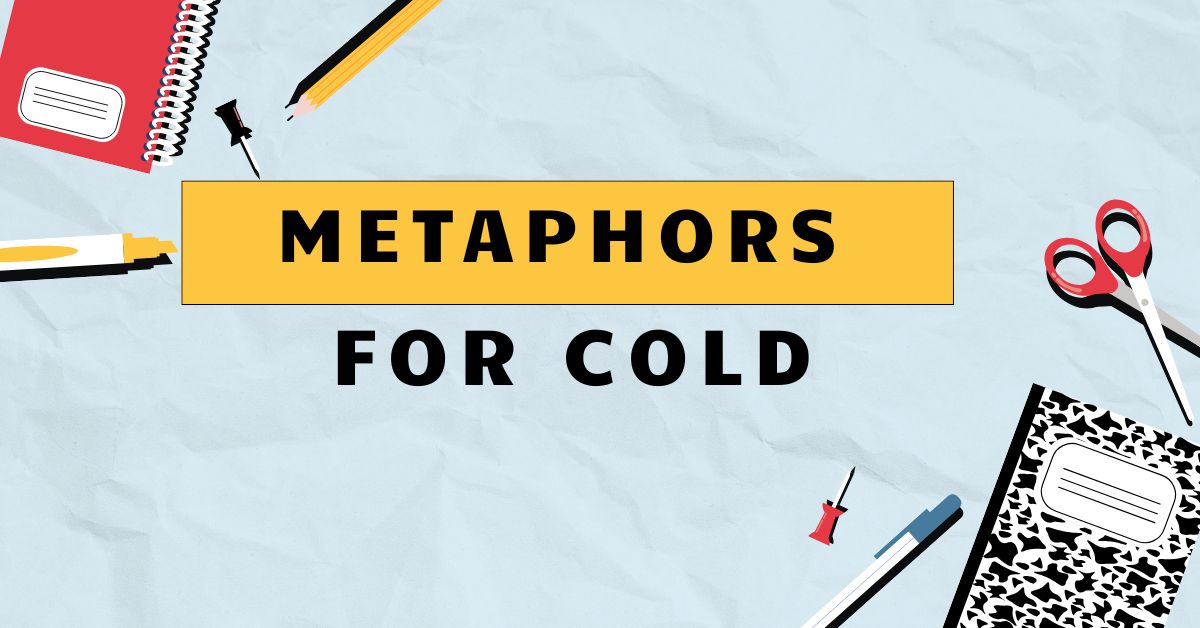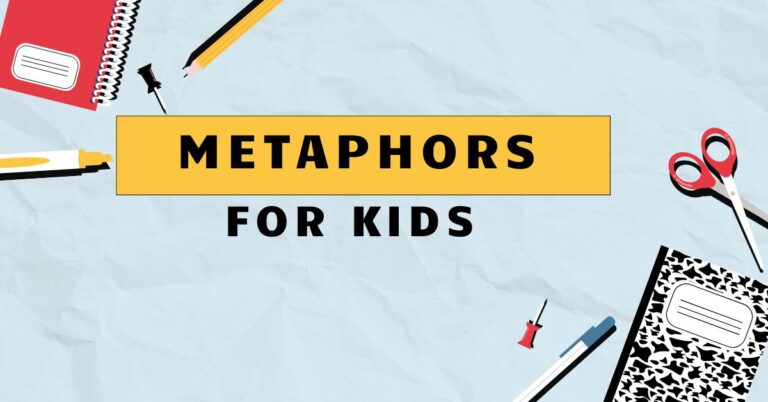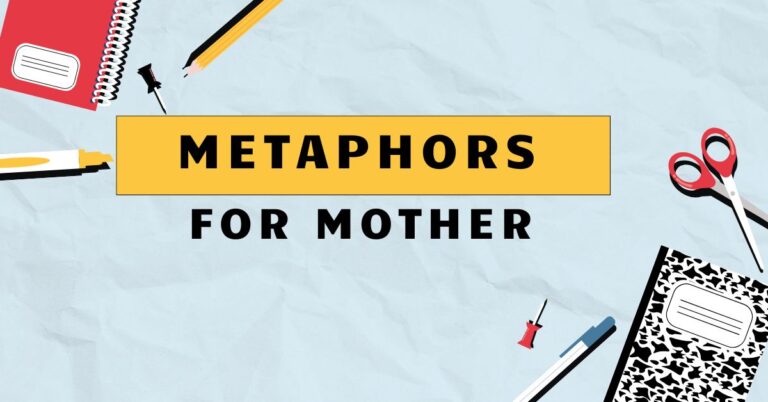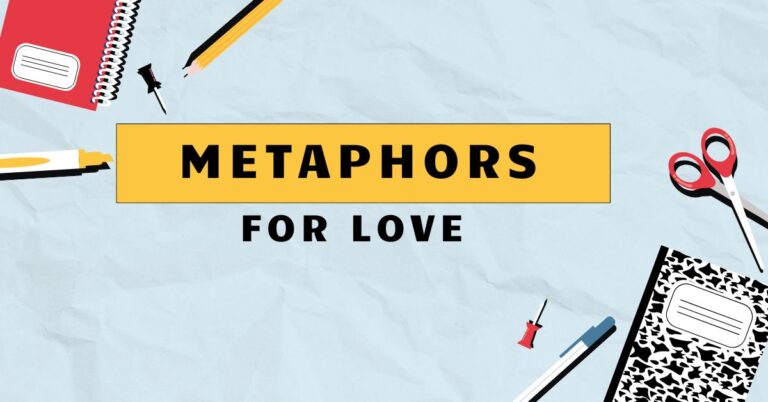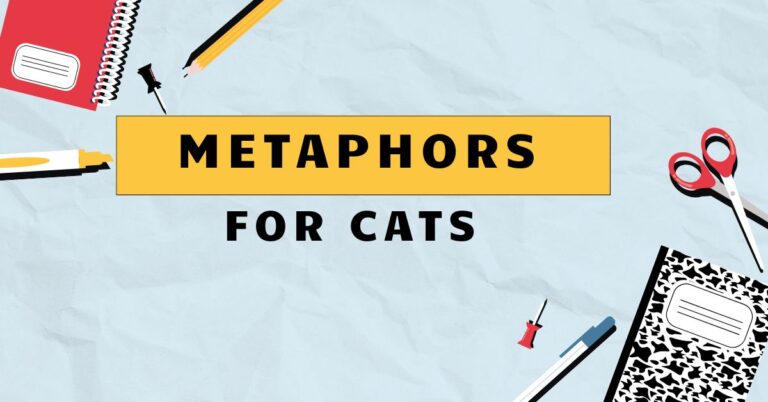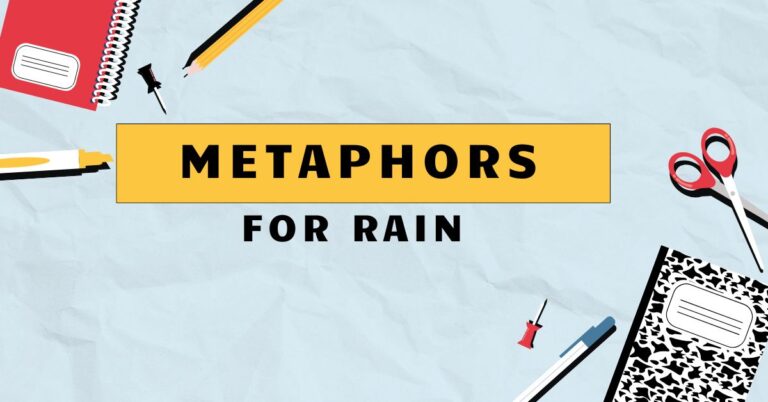41 Metaphors for Cold: Understanding Figurative Language
Metaphors are powerful tools in the English language, allowing us to express abstract ideas and emotions in vivid and relatable ways. Understanding metaphors, particularly those describing the sensation of cold, enriches both our comprehension and expression.
This article explores the diverse metaphors used to convey coldness, examining their structure, usage, and impact. This guide is beneficial for English language learners, writers, and anyone interested in enhancing their linguistic skills and creative expression.
Table of Contents
- Introduction
- Definition of Metaphor and Its Role
- Structural Breakdown of Cold Metaphors
- Types of Cold Metaphors
- Examples of Cold Metaphors
- Usage Rules for Cold Metaphors
- Common Mistakes with Cold Metaphors
- Practice Exercises
- Advanced Topics in Cold Metaphors
- Frequently Asked Questions
- Conclusion
Definition of Metaphor and Its Role
Ametaphoris a figure of speech that directly compares two unrelated things, asserting that one thingisanother. Unlike similes, which use “like” or “as” to make a comparison, metaphors create a direct equivalence, lending vividness and depth to language.
Metaphors function by transferring qualities or characteristics from one concept to another, allowing us to understand something unfamiliar in terms of something familiar.
In the context of “cold,” metaphors are used to describe not only physical coldness but also emotional coldness, social coldness, and even abstract concepts like “cold hard facts.” The function of these metaphors is to evoke a specific feeling or understanding in the reader or listener, painting a picture that goes beyond a literal description.
Structural Breakdown of Cold Metaphors
The structure of a metaphor typically involves two key elements: thetenorand thevehicle. The tenor is the subject being described (in this case, coldness), and the vehicle is the object or concept used to describe the tenor.
The connection between the tenor and vehicle is what creates the metaphorical meaning.
Consider the metaphor “Her stare was icy.” Here, “stare” (the tenor) is being described in terms of “icy” (the vehicle). The shared characteristic is the feeling of coldness and emotional distance.
The effectiveness of a metaphor depends on how well the vehicle conveys the intended qualities of the tenor.
Metaphors for cold can also incorporate extended metaphors, where the comparison is sustained over multiple sentences or even paragraphs. This allows for a more nuanced and detailed exploration of the concept of coldness.
Understanding the structural elements of metaphors helps us analyze and appreciate their impact on language.
Types of Cold Metaphors
Metaphors for cold can be categorized based on what aspect of coldness they are emphasizing. This classification helps to understand the different ways coldness can be expressed figuratively.
Physical Sensations
These metaphors focus on the physical feeling of coldness, such as shivering, numbness, or the biting sensation of cold air. They often use imagery related to ice, frost, and winter.
Emotional States
Emotional coldness is conveyed through metaphors that describe detachment, indifference, or a lack of warmth in relationships. These metaphors might use terms like “heart of ice” or “frozen feelings.”
Environmental Conditions
These metaphors describe environments that are cold, either literally or figuratively. They can be used to depict desolate landscapes, sterile environments, or situations that lack warmth and comfort.
Examples of Cold Metaphors
Here are examples of metaphors for cold, organized by the categories described above. Each category provides a range of metaphors to illustrate the diversity of figurative language.
Physical Sensations Examples
The following table provides examples of metaphors used to describe physical sensations of coldness, focusing on how they evoke the feeling of cold.
| Metaphor | Explanation |
|---|---|
| The wind was a knife, slicing through his skin. | The wind’s sharpness is compared to a knife, emphasizing its biting cold. |
| Her breath frosted in the air. | The visible condensation of breath is likened to frost, illustrating the extreme cold. |
| His fingers were icicles. | Fingers are directly compared to icicles, highlighting their frozen state. |
| The cold seeped into his bones. | The cold is described as penetrating deeply, affecting even the bones. |
| She was a popsicle after waiting outside. | Her body temperature is compared to a popsicle, emphasizing how cold she became. |
| His teeth chattered like castanets. | The rapid chattering of teeth is compared to the sound of castanets, emphasizing the uncontrollable shivering. |
| The air was a frozen blanket. | The air is described as covering everything like a blanket, but with a frigid quality. |
| His blood turned to ice. | The feeling of extreme cold is metaphorically described as blood solidifying. |
| The room was a refrigerator. | The extreme cold of the room is directly compared to a refrigerator. |
| The snow was a shroud. | The snow is described as a covering, like a burial shroud, emphasizing the deathly cold. |
| His skin was parchment. | Skin is described as being thin and dried out like parchment paper, a common side effect of extreme cold. |
| The ground was iron. | The ground is described as being hard and unyielding like iron due to the extreme cold. |
| He was a statue in the cold. | His immobility due to the cold is compared to a statue. |
| The lake was a mirror of ice. | The frozen lake is described as being as smooth and reflective as a mirror. |
| The cold air bit at his cheeks. | The cold air is described as being aggressive and painful. |
| The wind howled like a frozen wolf. | The sound of the wind is described as being harsh and cold. |
| His breath was a plume of smoke. | The visible breath in the cold air is compared to smoke. |
| The snow crunched like broken glass. | The sound of walking on snow is described as being sharp and brittle. |
| The frost painted the windows with silver. | The frost is described as creating intricate patterns on the windows. |
| The cold was a vise around his chest. | The feeling of tightness and constriction is compared to a vise. |
| He felt like an iceberg adrift at sea. | He feels isolated and alone, like an iceberg. |
| The chill was a ghost that lingered. | The lingering cold is compared to a haunting presence. |
| The cold air was a surgeon’s scalpel. | The precise and biting cold is compared to a surgeon’s scalpel. |
| His body was a frozen battlefield. | His body is experiencing an internal struggle against the cold. |
Emotional States Examples
The following table provides examples of metaphors used to describe emotional coldness, emphasizing feelings of detachment, indifference, or lack of warmth.
| Metaphor | Explanation |
|---|---|
| Her heart was an iceberg. | Describes a person’s lack of warmth and empathy. |
| His words were glacial. | His speech is described as slow, cold, and distant. |
| She gave him an arctic stare. | Her stare is described as intensely cold and unwelcoming. |
| Their relationship was frozen over. | The relationship is depicted as having lost its warmth and vitality. |
| He had a frosty demeanor. | His behavior is described as cold and unfriendly. |
| Her smile was as cold as winter. | The smile lacks genuine warmth and is perceived as insincere. |
| His anger was a blizzard. | His anger is described as intense, overwhelming, and destructive. |
| She was a snow queen. | She is described as beautiful but emotionally distant and unapproachable. |
| His silence was a deep freeze. | His silence is described as creating an atmosphere of coldness and tension. |
| Her rejection was like a slap of ice. | The rejection is described as sudden, shocking, and painful. |
| He built walls of ice around his heart. | He is protecting himself from emotional pain by becoming emotionally detached. |
| Her tears were frozen. | Her sadness is so profound that she is unable to express it. |
| His soul was winter. | His inner self is described as being cold, barren, and lifeless. |
| She was a glacier of indifference. | She is described as being extremely detached and uncaring. |
| His love had turned to frost. | His feelings of love have become cold and bitter. |
| She gave him the cold shoulder. | She is intentionally ignoring him and being unfriendly. |
| He had a heart of stone. | He is described as being unfeeling and incapable of empathy. |
| Her words were like shards of ice. | Her words are described as being sharp, hurtful, and cutting. |
| He was an emotional Eskimo. | He is described as being emotionally isolated and distant. |
| Her empathy was a frozen wasteland. | Her capacity for empathy is described as being completely absent. |
| The news hit him like a bucket of ice water. | The news was shocking and unpleasant. |
| His spirit was in deep freeze. | His enthusiasm and motivation has been suppressed. |
| She had a frigid personality. | Her personality is perceived as being cold and uninviting. |
| He treated her with arctic disdain. | He is showing her extreme contempt and coldness. |
| Their friendship had become a frozen tundra. | Their friendship has deteriorated and become barren. |
Environmental Conditions Examples
The following table provides examples of metaphors used to describe environmental conditions that evoke feelings of coldness, either literally or figuratively.
| Metaphor | Explanation |
|---|---|
| The office was an icebox. | The office environment is described as being extremely cold and unwelcoming. |
| The city was a frozen wasteland. | The city is depicted as being desolate, barren, and devoid of life. |
| The atmosphere was glacial. | The overall mood or environment is described as cold, tense, and unwelcoming. |
| The room was a refrigerator. | The room is described as being extremely cold, like a refrigerator. |
| The landscape was a frozen canvas. | The landscape is depicted as being covered in snow and ice, resembling a painting. |
| The silence was a winter’s night. | The silence is described as being deep, cold, and unsettling. |
| The meeting was a deep freeze. | The meeting is described as being unproductive and lacking warmth or collaboration. |
| The project was left out in the cold. | The project has been abandoned or neglected. |
| The business climate was arctic. | The business environment is described as being harsh, competitive, and unforgiving. |
| The political landscape was a frozen tundra. | The political environment is described as being barren, unproductive, and divided. |
| The economy was in a deep freeze. | The economy is experiencing a period of stagnation and decline. |
| The negotiations were ice-cold. | The negotiations are described as being tense, difficult, and lacking warmth. |
| The system was a glacial bureaucracy. | The system is described as being slow, inefficient, and unresponsive. |
| The opportunity was left to freeze. | The opportunity was missed or allowed to expire. |
| The social scene was a frozen lake. | The social environment is described as being cold, superficial, and unwelcoming. |
| The legal process was an iceberg. | The legal process is described as being complex, hidden, and dangerous. |
| The research was put on ice. | The research has been temporarily suspended or postponed. |
| The atmosphere was as chilling as a morgue. | The atmosphere is described as being eerily cold and lifeless. |
| The room felt like a meat locker. | The room is described as being extremely cold and unpleasant. |
| The abandoned house was a tomb. | The abandoned house is described as being cold, lifeless, and decaying. |
| The project became a frozen asset. | The project is no longer generating value or progress. |
| The relationship was an icy stalemate. | The relationship has reached a point of stagnation and conflict. |
| The debate was a cold war. | The debate is described as being tense, hostile, and lacking resolution. |
| The negotiation room was a freezer. | The negotiation room is described as being cold, tense, and unwelcoming. |
| The building was a mausoleum. | The building is described as being cold, imposing, and reminiscent of death. |
Usage Rules for Cold Metaphors
Using metaphors effectively requires an understanding of their nuances and the contexts in which they are appropriate. Here are some guidelines:
- Clarity: Ensure the connection between the tenor and the vehicle is clear. The audience should easily understand the intended comparison.
- Context: Consider the context of your writing or speech. A metaphor that works in one situation may not be effective in another.
- Originality: While some metaphors are common, strive for originality to make your writing more engaging and memorable. Avoid clichés.
- Consistency: If using an extended metaphor, maintain consistency throughout the passage. Mixing metaphors can confuse the reader.
For example, saying “Her heart was a refrigerator” might not be as effective as “Her heart was an iceberg” because a refrigerator, while cold, is also functional and contains things. An iceberg better conveys the idea of something massive, cold, and potentially dangerous lurking beneath the surface.
Common Mistakes with Cold Metaphors
Here are some common mistakes to avoid when using metaphors for cold:
| Mistake | Correct Example | Incorrect Example |
|---|---|---|
| Mixing Metaphors | The project was a slow-moving glacier. | The project was a slow-moving glacier that also sailed smoothly. |
| Clichés | His words were sharp as winter wind. | His words were like ice. |
| Unclear Comparison | Her smile was a stone. | Her smile was a frozen stone. (More clear) |
| Inappropriate Context | The party was an arctic blast. (Unless the party was a failure) | The party was a warm and inviting gathering. |
Mixing metaphors occurs when you combine two or more incompatible metaphors in a single expression. This can create confusion and undermine the effectiveness of your writing.
Clichésare overused metaphors that have lost their impact. While they may be easily understood, they lack originality and can make your writing seem uninspired.
Strive for fresh and creative comparisons.
Anunclear comparisonhappens when the connection between the tenor and vehicle is not readily apparent. The audience may struggle to understand the intended meaning of the metaphor.
Ensure the comparison is logical and relevant.
Using a metaphor in an inappropriate context can also detract from its effectiveness. Consider the tone and subject matter of your writing and choose metaphors that align with the overall message.
Practice Exercises
Test your understanding of metaphors for cold with these exercises.
| Exercise | Question | Answer |
|---|---|---|
| 1 | Identify the metaphor: “His heart was a frozen lake.” | His heart is being compared to a frozen lake. |
| 2 | Rewrite the sentence with a metaphor: “The wind was very cold.” | The wind was a frigid caress. |
| 3 | Is “He gave her the cold shoulder” a metaphor or simile? | Metaphor |
| 4 | Create a metaphor for “emotional distance.” | Walls of ice |
| 5 | Identify the tenor and vehicle: “Her words were shards of ice.” | Tenor: Words; Vehicle: Shards of ice |
| 6 | What type of metaphor is “The office was an icebox”? | Environmental Condition |
| 7 | Complete the metaphor: “The silence was as cold as…” | …a winter’s night. |
| 8 | Rewrite the sentence using a cold metaphor: “The rejection was painful.” | The rejection was like a slap of ice. |
| 9 | Create a metaphor to describe a cold personality. | A glacier of indifference |
| 10 | What does it mean when someone says “He was left out in the cold”? | He was excluded or ignored. |
Exercise 11: Identify the metaphor in the sentence: “The news hit him like a bucket of ice water.”
Answer: The news is being compared to a bucket of ice water.
Exercise 12: Rewrite the sentence using a metaphor for cold: “The atmosphere in the room was tense.”
Answer: The atmosphere in the room was glacial.
Exercise 13: Is the phrase “cold as ice” a metaphor or a simile?
Answer: Simile
Exercise 14: Create a metaphor to describe a lack of empathy.
Answer: A heart of stone.
Exercise 15: Identify the tenor and vehicle in the sentence: “His anger was a blizzard.”
Answer: Tenor: Anger; Vehicle: Blizzard.
Exercise 16: What type of metaphor is the phrase “a frozen wasteland” in reference to a city?
Answer: Environmental Condition.
Exercise 17: Complete the metaphor: “Her stare was as cold as…”
Answer: …an arctic wind.
Exercise 18: Express the following idea using a cold metaphor, “She was very distant and unfriendly.”
Answer: She gave him the cold shoulder.
Exercise 19: Develop a metaphor for a business environment that is unforgiving.
Answer: A business climate was arctic.
Exercise 20: What is the figurative meaning of the expression, “The project was put on ice”?
Answer: The project was temporarily suspended.
Advanced Topics in Cold Metaphors
For advanced learners, exploring the cultural and historical contexts of cold metaphors can provide deeper insights. Different cultures may associate different meanings with coldness, influencing the metaphors they use.
For example, in some cultures, snow and ice are symbols of purity and renewal, while in others, they may represent death and desolation.
Analyzing the use of cold metaphors in literature can also be a rewarding exercise. Authors often use metaphors to create atmosphere, develop characters, and explore complex themes.
Examining how these metaphors are employed can enhance your understanding of both the text and the nuances of figurative language.
Furthermore, exploring the psychological impact of cold metaphors can provide a deeper understanding of how language affects our emotions and perceptions. Metaphors can evoke strong feelings and shape our understanding of the world around us.
Understanding these effects can make you a more effective communicator and a more discerning reader.
Frequently Asked Questions
Here are some frequently asked questions about metaphors for cold:
- What is the difference between a metaphor and a simile?
A metaphor directly equates two things (e.g., “Her heart was an iceberg”), while a simile uses “like” or “as” to make a comparison (e.g., “Her heart was like an iceberg”). Metaphors are more forceful and create a stronger sense of equivalence.
- Why are metaphors important in language?
Metaphors enrich language by adding vividness, depth, and emotional resonance. They allow us to express complex ideas in relatable ways and create a more engaging reading or listening experience.
- How can I improve my use of metaphors?
Read widely, pay attention to how authors use metaphors, and practice creating your own. Be mindful of clarity, context, and originality. Avoid clichés and mixing metaphors.
- What are some common clichés involving cold metaphors?
Common clichés include “cold as ice,” “cold shoulder,” and “heart of stone.” While easily understood, these phrases lack originality and should be used sparingly.
- Can metaphors have different meanings in different cultures?
Yes, cultural context can influence the meaning of metaphors. It’s important to be aware of these differences when communicating with people from different backgrounds.
- How do I identify a metaphor in a sentence?
Look for a statement that equates two unrelated things. If the statement is not literally true but creates a meaningful comparison, it is likely a metaphor.
- What is an extended metaphor?
An extended metaphor is a metaphor that is sustained over multiple sentences or paragraphs. It allows for a more detailed and nuanced exploration of the comparison.
- How can metaphors for cold be used in creative writing?
Metaphors for cold can be used to create atmosphere, develop characters, and explore themes such as isolation, detachment, and loss. They can add depth and emotional resonance to your writing.
- What is the difference between tenor and vehicle in a metaphor?
The tenor is the subject being described, while the vehicle is the object or concept used to describe the tenor. For example, in “Her heart was an iceberg,” “heart” is the tenor and “iceberg” is the vehicle.
- How can I avoid mixing metaphors?
Carefully consider the images and concepts you are using and ensure they are compatible. Avoid combining metaphors that create contradictory or nonsensical images.
- Are there any situations where using a cold metaphor would be inappropriate?
Yes, using a cold metaphor would be inappropriate in situations where warmth and empathy are needed, such as consoling someone who is grieving or celebrating a joyous occasion.
Conclusion
Metaphors for cold provide a rich tapestry of figurative language, enhancing our ability to express and understand complex ideas and emotions. By understanding the structure, types, and usage rules of these metaphors, we can improve our communication skills and appreciate the artistry of language.
From describing physical sensations to emotional states and environmental conditions, metaphors for cold offer a powerful tool for creative expression.
Mastering metaphors requires practice and attention to detail. By studying examples, avoiding common mistakes, and engaging in exercises, you can develop your ability to use metaphors effectively.
Remember to consider the context, strive for originality, and maintain consistency in your use of figurative language. With these skills, you can unlock the full potential of metaphors and elevate your writing and speaking to new heights.

